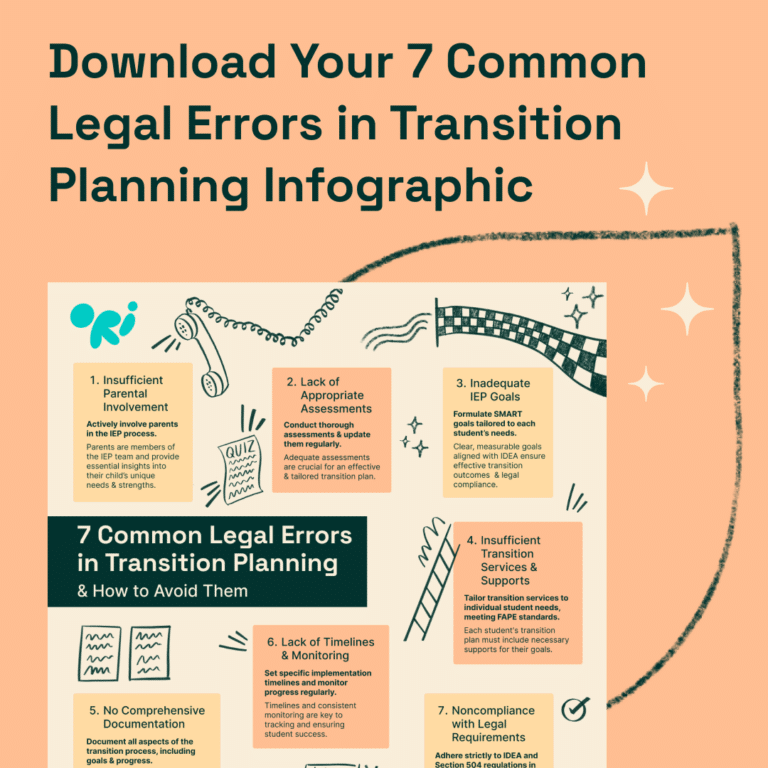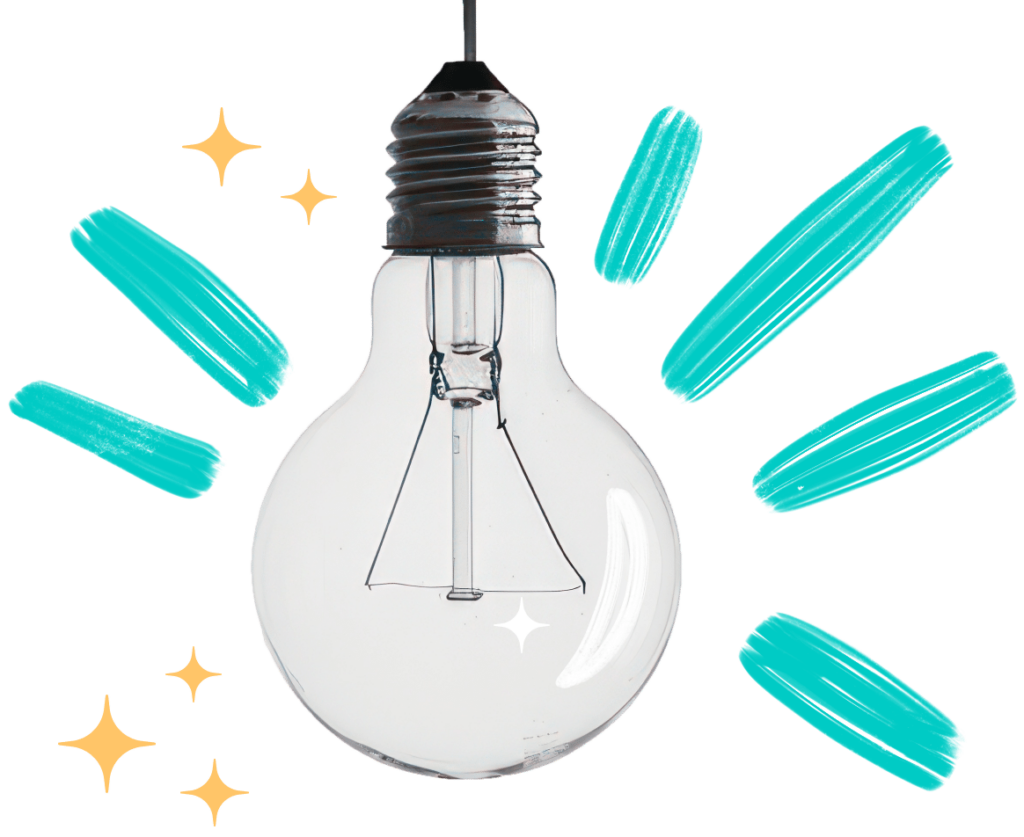


Students enrolled in special education who have an Individual Education Plan (IEP) will have a transition plan as part of their IEP by age 16 (or sometimes even earlier, in the case of many states).
The purpose of this plan is to capture goals, which are decided by the student and other stakeholders, that are important to reach in preparation for life after completing their education. In line with each of these goals, the transition plan outlines the strategies and activities which will be used to support them and names the service providers who will be responsible for implementing them with fidelity according to a timeline.
The Individuals with Disabilities Education Act (IDEA) encompasses transition planning and related guidance. In particular, Part 300 mandates that state is responsible for providing “free appropriate public education,” or FAPE, to each child with a disability. These responsibilities include providing special education tailored to each student’s needs to prepare them for education, the workplace, and independent living. The latter includes recreation, leisure activities, community participation, and domestic life.
Part 300 further specifies 16 as the age when transition planning must begin and 18 for the transfer of parental rights, though both ages may differ depending on the state. IDEA also covers federal funding uses for transition, including the use of funding to develop and implement transition programs and coordinate services among agencies working with students with disabilities.
No Child Left Behind (NCLB), which was passed into law in 2001, brought changes that directly impacted students with disabilities. The new law required data for students with disabilities to be disaggregated from the general student population so that test scores and other educational outcomes could be reported separately. This would help identify any gaps or disparities in the educational system as well as opportunities to implement accommodations for this group.
In 2015, the Every Student Succeeds Act (ESSA) replaced NCLB. The primary change made was greater state control over standards-based reform, while not doing so at the expense of certain standards, including requiring that students with disabilities have have the same math, reading, and science attainment levels as other students. Furthermore, Alternate Academic Achievement Standards (AAAS) and the Alternative Diploma concept were introduced as an option for students with the most severe cognitive disabilities, but with similar requirements for teachers to demonstrate progress and meet the standards for FAPE.
Several other laws beyond the above-mentioned education-specific legislation also had consequences for students’ post-secondary readiness. In 2015, the Workforce Investment Act (WIA) of 1998 was amended to the Workforce Innovation and Opportunity Act (WIOA). With this amendment, services were expanded to also include students with disabilities. Also, schools and adult service providers (e.g. vocational rehabilitation) were to collaborate to improve post-secondary outcomes for those with disabilities.
The Strengthening Career and Technical Education for the 21st Century Act, or Perkins V, followed in 2018. The most recent iteration of the federal Perkins Act underscores the importance of data disaggregation requirements: states are to develop local school system evaluations that capture specific needs and employment gaps for special populations, including individuals with disabilities.
Litigation has been a powerful force in further shaping how these laws are and should continue to be enacted. Knowledge and experience determine special education leaders’ ability to ensure compliance and advocate on behalf of their students.
Stakeholders in the transition planning process collaborate to determine the range of special education services across four key areas: academics, vocational training and career exploration, community engagement and independent living, and social and emotional well-being. These services support students in reaching their post-secondary goals.
Curriculum and course selection are important considerations for achieving post-secondary goals. For example, if a student takes a general studies curric ulum, as frequently happens with students with disabilities, they may not meet the requirements to attend a four-year college. Course waivers can also limit higher education options. It is therefore imperative to thoroughly understand students’ post-secondary educational goals and make decisions based on these in order to increase instead of limit their options.
Course pacing is another area to carefully consider, since the ability to be flexible can be beneficial to lifelong success. For example, taking four and a half or five years to complete high school rather than four may better prepare students in terms of knowledge, skills, and positive self-concept for post-secondary success, allowing students to take the time to understand and absorb the material rather than merely aiming for completion.
This component emphasizes the development of self-management and inter-personal skills to prepare students to be able to live independently and contribute effectively as members of the wider community.
Independent living covers essential areas like daily living, personal health, and financial management skills, teaching students how to handle everyday tasks, look after themselves, and budget their resources respectively.
Community engagement encompasses effective communication, empathy, and teamwork, which are vital for building relationships, resolving conflicts, and collaborating with others in community projects and initiatives.
Research indicates that students with disabilities who have developed their social skills increase their likelihood of success in employment, community living, and post-secondary education, complementing the first three key focus areas and thus significantly enhancing a student’s overall quality of life.
For students with disabilities, mastering SEL skills is crucial for building resilience, positive self-image, and navigating life’s challenges effectively. Inclusion of SEL in the transition curriculum not only prepares them for adult life’s practicalities but also for forming meaningful relationships and participating confidently in their communities.
Social emotional learning skills should be taught in a systematic, structured way as part of the transition curriculum.

In the realm of transition planning, special education leaders play a pivotal role: they are not only in charge of curating and refining the core curriculum, but they also facilitate access to essential resources and services like vocational training and life skills development, as well as advocating for policy changes and funding to enhance transition services.
As a result, the professional models and frameworks they utilize will inevitably guide their expertise in creating and implementing a seamless and effective transition process, ensuring that each student’s journey from school to adult life is personalized, well-supported, and aligned with their individual goals and needs. We outline some of the main research-backed frameworks below.
While education professionals are guided by their own education and training, their personal experience, the ways in which it has shaped them and their worldview and the extent to which it might influence their decision-making, is also an important factor. Worth bearing in mind are the following:
The Taxonomy of Transition 2.0 specifically includes interagency collaboration, with collaboration being a theme that runs through the entire framework. Collaborative efforts need to include identifying a responsible representative or contact for each agency, adopting interagency agreements to clarify roles and responsibilities, data-sharing within the bounds allowed by HIPAA, and participating in cross-agency professional development.
The partnership between Alabama Department of Rehabilitation Services (ADRS), Auburn University, and statewide schools showcases effective interagency work to prevent service duplication. A key initiative is a web-based “back-to-school” survey, co-developed with Auburn University, which gathers information from schools about their planned pre-Employment Transition Services (pre-ETS) activities. This data helps ADRS manage pre-ETS effectively. Vocational rehabilitation staff conducted 18 statewide meetings with over 300 school systems to kick off this annual initiative.
Education leaders Besides the student, their teachers, and their parents or caregivers, various other stakeholders should be part of transition planning. These stakeholders should include representatives of services that contribute to effective transitions and comprise one or more of the following: representatives from school-to-work transition programs, local social service agencies, counseling programs, medical care providers, and advocates
Below we outline how students can actively prepare for post-graduation life and the supportive strategies school counselors can employ to facilitate this important transition.
Students must be prepared to advocate for themselves, whether in transition planning meetings or as they navigate their way after high school. To increase the chance for effective leadership, students need to understand how they can prepare for transition planning by:
Transition support specialists are key facilitators in the journey from high school to post-secondary life. They bring specialized knowledge of vocational and adult living resources that are specific to the needs of students with disabilities. Their role is most crucial in the following areas:
School counselors provide services to the entire student body, but in the context of special education, they ensure that their services are inclusive and accessible to students with disabilities. They further help facilitate successful transitions by:
Understand the challenges that educators, policymakers, and parents of special education students will face in the year ahead.

The Alaska JOBZ Club is the product of successful interagency collaboration among the Alaska Department of Labor and Workforce Development’s Division of Vocational Rehabilitation (DVR) and the Division of Employment and Training Services (DETS), the Alaska Department of Education and Early Development, and local education agencies and teachers.
With this program, current teachers are contracted to provide pre-employment training services to students with disabilities after school. This approach helps ensure students have access to these activities even if they live in remote or hard-to-reach areas of the state. The focus on soft skills also means that learning will be useful whether a student goes on to live in a rural or urban area in the future.
Six principals were chosen for a study on inclusive schools conducted by DeMatthews et. al. based on their ability to implement inclusive practices in their respective schools, which are located in a low-income district on the Mexican-American border.
Prior research had demonstrated that “low-income students of color with (and without) disabilities continue to be denied opportunities to participate in schooling alongside their peers”. The chosen principals mention that a lack of adequate teacher training and proactive collaboration was to blame for perpetuating some of these negative biases.
This was what prompted them to shift their leadership towards challenging the status quo and encouraging their staff to grapple with assumptions about special education and inclusion. The study goes on to recommend conducting equity audits that examine attitudes to race and disability in schools and introducing specific instruction that enhances teachers’ understanding of intersectionality.
Effective transition services should focus on four areas: academics, vocational training, independent living, and community engagement. Transition planning should start by age 16 as per IDEA, but some states may begin earlier.
Special education leaders orchestrate transition planning, ensuring students receive tailored education, vocational training, and life skills for post-secondary success.
These services teach essential life skills and foster community involvement, crucial for students’ independence and social integration post-graduation.
Transition services are integral towards shaping the post-secondary lives of students. The multi-faceted nature of what students need to reach their full potential makes effective leadership imperative. Those in special education are uniquely positioned to draw on their education, experience, and leadership capabilities as well as evidence and best practices to rally stakeholders and drive decision-making across all levels.
Ori Learning’s Transition Curriculum encompasses modules on employability, workplace readiness, social skills and emotional well-being, and financial literacy. Designed for students with mild and mild/moderate disabilities, accessibility features enable every student to access quality learning in a way that fits their needs. Embedded data collection tools enable efficient progress monitoring. Reports can be easily generated so that they can support collaboration and evidence-based decision making by stakeholders.
Receive custom support backed by rich industry experience that can help you tackle your strategic goals at scale. Request a free demo of our platform to experience first-hand its powerful accommodation and translation features and intuitive design based on UDL principles.


A native of Wales, UK and currently residing in Florida, Roz received her graduate degree in Special Education from the University of Central Florida and holds a Board Certification in Behavior Analysis (BCBA). With over 20 years of experience in special education and disability and advocacy services, Roz has worked with national and international non-profits and EdTech organizations leading successful program and operational teams to improve outcomes for our most vulnerable children and adults. Roz currently leads the Ori Learning team in the role of Chief Operating Officer.

